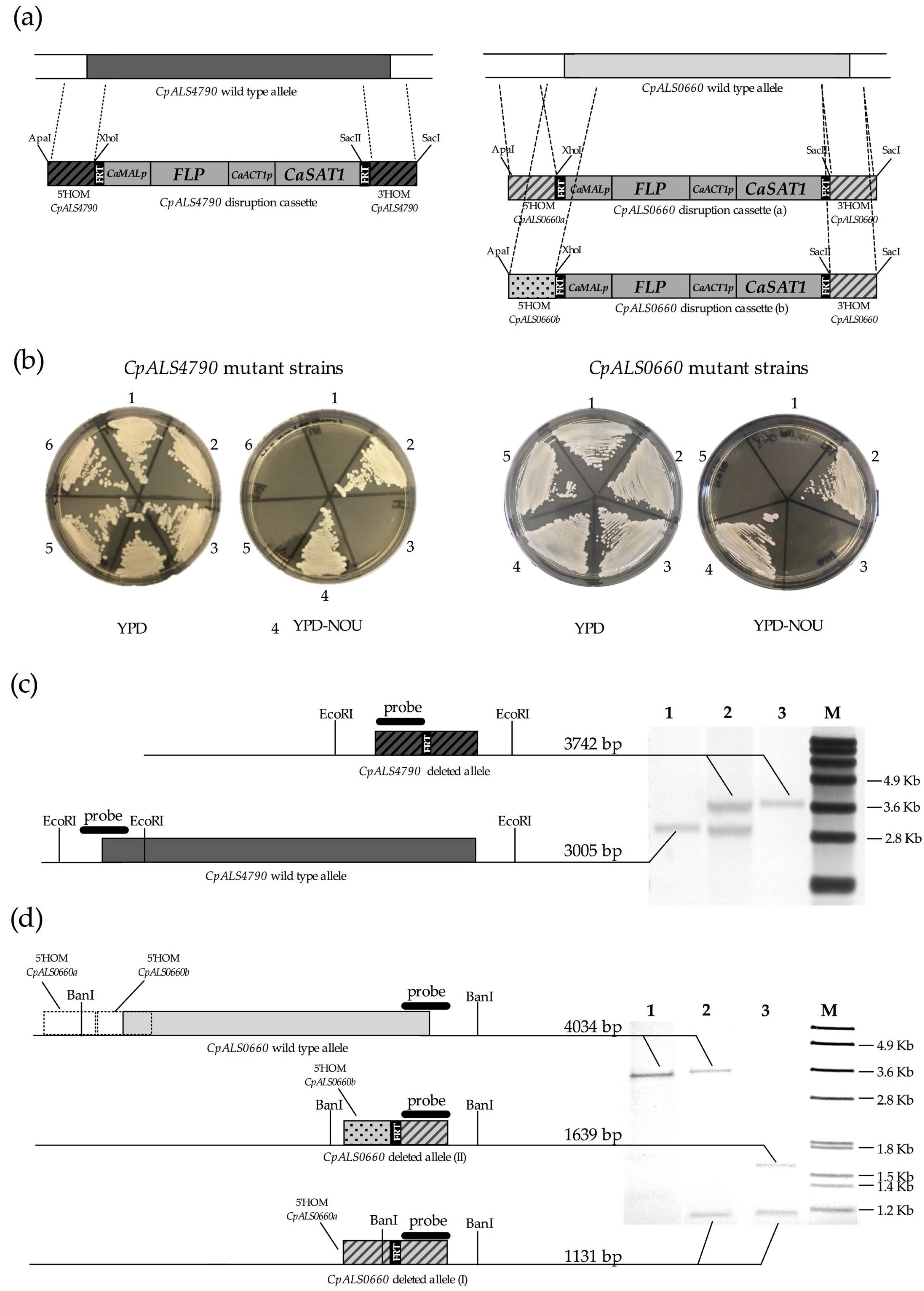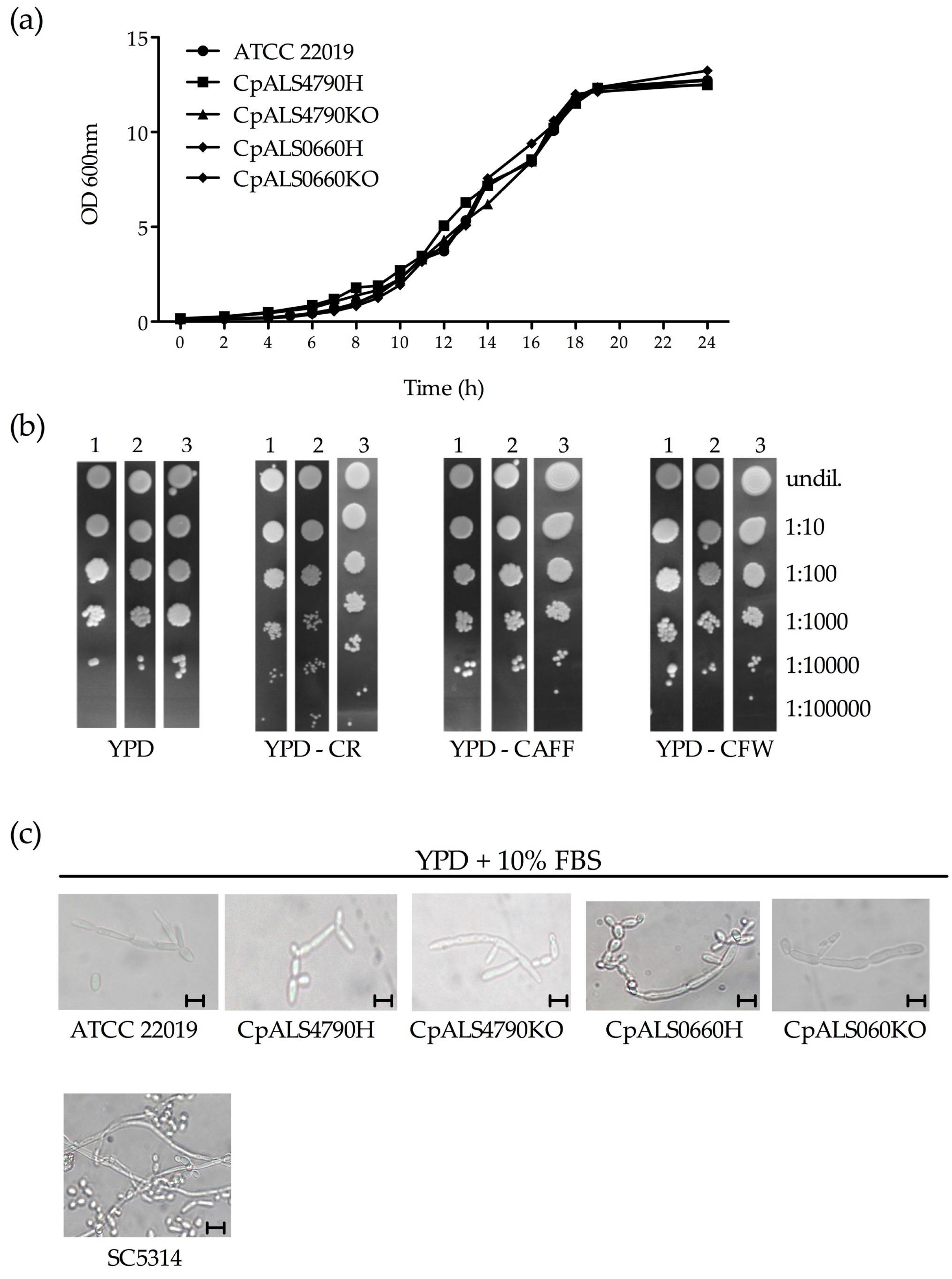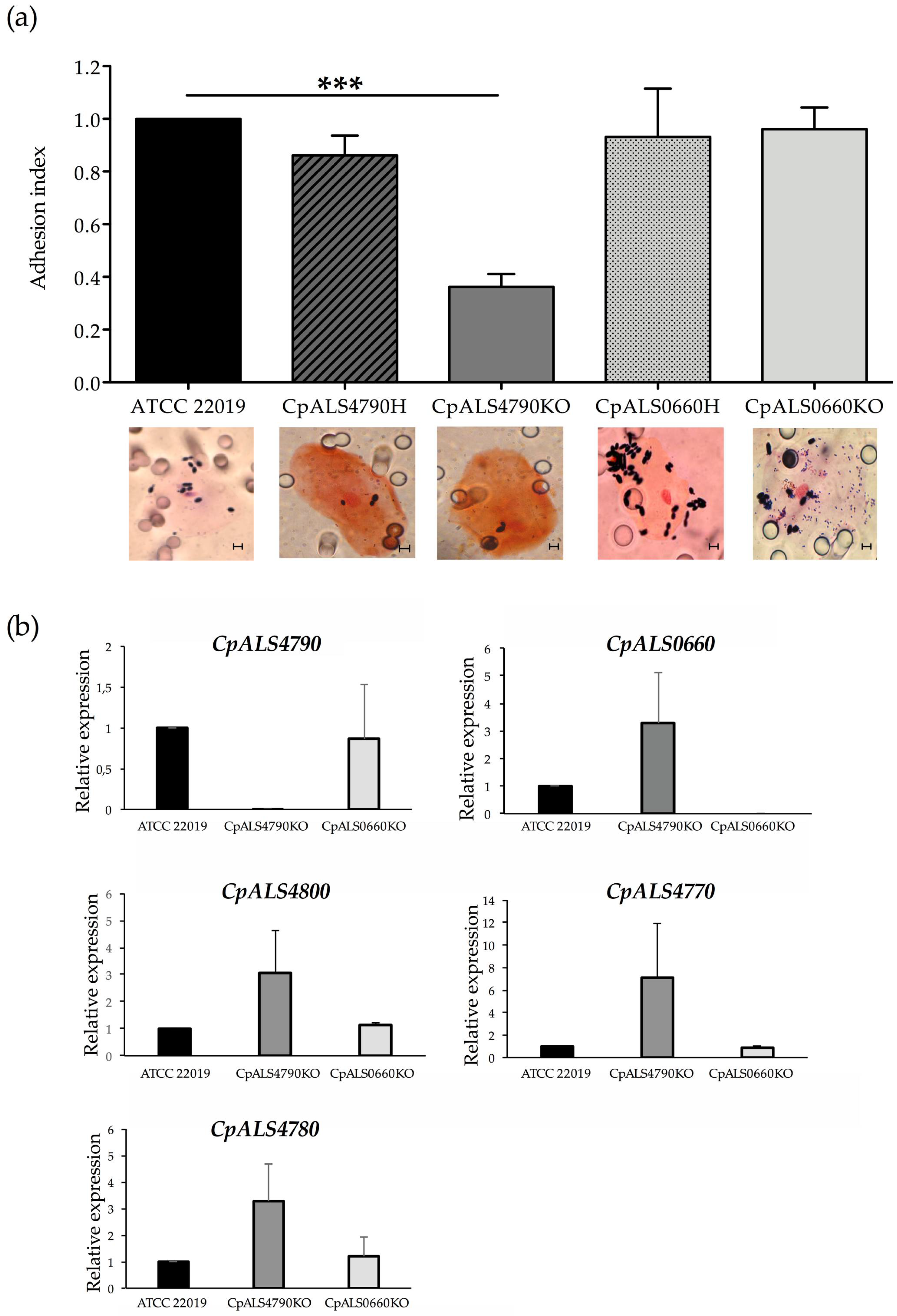Role of CpALS4790 and CpALS0660 in Candida parapsilosis Virulence: Evidence from a Murine Model of Vaginal Candidiasis
Abstract
1. Introduction
2. Materials and Methods
2.1. Strains and Plasmids Used in This Study
2.2. Construction of CpALS4790 and CpALS0660 Disruption Cassettes
2.3. C. parapsilosis Transformation and Screening of the Mutant Collection
2.4. Southern Blot Analysis
2.5. Growth Ability and Morphogenesis
2.6. Adhesion on Human Buccal Epithelial Cells (HBECs)
2.7. Quantitative Analysis of CpALS Genes Expression in Co-Incubation with HBECs
2.8. Murine Model of Vaginal Candidiasis
2.9. Scanning Electron Microscopy (SEM)
3. Results
3.1. Construction and Genotypic Characterization of CpALS4790 and CpALS0660 Mutant Strains
3.2. CpALS4790 and CpALS0660 Mutants Display Similar Growth Rates and Morphogenetic Properties as Compared to the Wild Type Strain
3.3. CpALS4790 and CpALS0660 are Differently Involved in the Adhesion Process of C. parapsilosis to HBECs
3.4. CpALS4790 and CpALS0660 Contribute to Cell Adhesion and Pathogenesis in a Murine Model of Vaginal Candidiasis.
4. Discussion
5. Conclusions
Supplementary Materials
Author Contributions
Funding
Acknowledgments
Conflicts of Interest
References
- Hoyer, L.L.; Cota, E. Candida albicans Agglutinin-Like Sequence (Als) Family Vignettes: A Review of Als Protein Structure and Function. Front. Microbiol. 2016, 7, 280. [Google Scholar] [CrossRef]
- Hoyer, L.L.; Scherer, S.; Shatzman, A.R.; Livi, G.P. Candida albicans ALS1: Domains related to a Saccharomyces cerevisiae sexual agglutinin separated by a repeating motif. Mol. Microbiol. 1995, 15, 39–54. [Google Scholar] [CrossRef] [PubMed]
- Tavanti, A.; Davidson, A.D.; Gow, N.A.; Maiden, M.C.; Odds, F.C. Candida orthopsilosis and Candida metapsilosis spp. nov. to replace Candida parapsilosis groups II and III. J. Clin. Microbiol. 2005, 43, 284–292. [Google Scholar] [CrossRef] [PubMed]
- Bliss, J.M. Candida parapsilosis: An emerging pathogen developing its own identity. Virulence 2015, 6, 109–111. [Google Scholar] [CrossRef] [PubMed][Green Version]
- Guinea, J. Global trends in the distribution of Candida species causing candidemia. Clin. Microbiol. Infect. 2014, 20 (Suppl. 6), 5–10. [Google Scholar] [CrossRef]
- Ward, T.L.; Dominguez-Bello, M.G.; Heisel, T.; Al-Ghalith, G.; Knights, D.; Gale, C.A. Development of the Human Mycobiome over the First Month of Life and across Body Sites. MSystems 2018, 3. [Google Scholar] [CrossRef]
- Ghannoum, M.A.; Jurevic, R.J.; Mukherjee, P.K.; Cui, F.; Sikaroodi, M.; Naqvi, A.; Gillevet, P.M. Characterization of the oral fungal microbiome (mycobiome) in healthy individuals. PLoS Pathog. 2010, 6, e1000713. [Google Scholar] [CrossRef]
- Butler, G.; Rasmussen, M.D.; Lin, M.F.; Santos, M.A.; Sakthikumar, S.; Munro, C.A.; Rheinbay, E.; Grabherr, M.; Forche, A.; Reedy, J.L.; et al. Evolution of pathogenicity and sexual reproduction in eight Candida genomes. Nature 2009, 459, 657–662. [Google Scholar] [CrossRef]
- Riccombeni, A.; Vidanes, G.; Proux-Wera, E.; Wolfe, K.H.; Butler, G. Sequence and analysis of the genome of the pathogenic yeast Candida orthopsilosis. PLoS ONE 2012, 7, e35750. [Google Scholar] [CrossRef]
- Pryszcz, L.P.; Nemeth, T.; Saus, E.; Ksiezopolska, E.; Hegedusova, E.; Nosek, J.; Wolfe, K.H.; Gacser, A.; Gabaldon, T. The Genomic Aftermath of Hybridization in the Opportunistic Pathogen Candida metapsilosis. PLoS Genet. 2015, 11, e1005626. [Google Scholar] [CrossRef]
- Lombardi, L.; Zoppo, M.; Rizzato, C.; Bottai, D.; Hernandez, A.G.; Hoyer, L.L.; Tavanti, A. Characterization of the Candida orthopsilosis agglutinin-like sequence (ALS) genes. PLoS ONE 2019, 14, e0215912. [Google Scholar] [CrossRef] [PubMed]
- Oh, S.H.; Smith, B.; Miller, A.N.; Staker, B.; Fields, C.; Hernandez, A.; Hoyer, L.L. Agglutinin-Like Sequence (ALS) Genes in the Candida parapsilosis Species Complex: Blurring the Boundaries Between Gene Families That Encode Cell-Wall Proteins. Front. Microbiol. 2019, 10, 781. [Google Scholar] [CrossRef] [PubMed]
- Zoppo, M.; Di Luca, M.; Franco, M.; Rizzato, C.; Lupetti, A.; Stringaro, A.; De Bernardis, F.; Schaudinn, C.; Barrasa, M.I.; Bottai, D.; et al. CpALS4770 and CpALS4780 contribution to the virulence of Candida parapsilosis. Microbiol. Res. 2020, 231, 126351. [Google Scholar] [CrossRef]
- Bertini, A.; Zoppo, M.; Lombardi, L.; Rizzato, C.; De Carolis, E.; Vella, A.; Torelli, R.; Sanguinetti, M.; Tavanti, A. Targeted gene disruption in Candida parapsilosis demonstrates a role for CPAR2_404800 in adhesion to a biotic surface and in a murine model of ascending urinary tract infection. Virulence 2016, 7, 85–97. [Google Scholar] [CrossRef] [PubMed]
- Reuss, O.; Vik, A.; Kolter, R.; Morschhauser, J. The SAT1 flipper, an optimized tool for gene disruption in Candida albicans. Gene 2004, 341, 119–127. [Google Scholar] [CrossRef]
- Zoppo, M.; Lombardi, L.; Rizzato, C.; Lupetti, A.; Bottai, D.; Papp, C.; Gacser, A.; Tavanti, A. CORT0C04210 is required for Candida orthopsilosis adhesion to human buccal cells. Fungal Genet. Biol. 2018, 120, 19–29. [Google Scholar] [CrossRef]
- Zoppo, M.; Luca, M.D.; Villarreal, S.N.; Poma, N.; Barrasa, M.I.; Bottai, D.; Vyas, V.K.; Tavanti, A. A CRISPR/Cas9-based strategy to simultaneously inactivate the entire ALS gene family in Candida orthopsilosis. Future Microbiol. 2019, 14, 1383–1396. [Google Scholar] [CrossRef]
- Bertini, A.; De Bernardis, F.; Hensgens, L.A.; Sandini, S.; Senesi, S.; Tavanti, A. Comparison of Candida parapsilosis, Candida orthopsilosis, and Candida metapsilosis adhesive properties and pathogenicity. Int J. Med. Microbiol. 2013, 303, 98–103. [Google Scholar] [CrossRef]
- Lombardi, L.; Oliveira-Pacheco, J.; Butler, G. Plasmid-Based CRISPR-Cas9 Gene Editing in Multiple Candida Species. MSphere 2019, 4. [Google Scholar] [CrossRef]
- Lombardi, L.; Turner, S.A.; Zhao, F.; Butler, G. Gene editing in clinical isolates of Candida parapsilosis using CRISPR/Cas9. Sci. Rep. 2017, 7, 8051. [Google Scholar] [CrossRef]
- Zhao, X.; Oh, S.H.; Yeater, K.M.; Hoyer, L.L. Analysis of the Candida albicans Als2p and Als4p adhesins suggests the potential for compensatory function within the Als family. Microbiology 2005, 151, 1619–1630. [Google Scholar] [CrossRef] [PubMed]
- Green, C.B.; Zhao, X.; Yeater, K.M.; Hoyer, L.L. Construction and real-time RT-PCR validation of Candida albicans PALS-GFP reporter strains and their use in flow cytometry analysis of ALS gene expression in budding and filamenting cells. Microbiology 2005, 151, 1051–1060. [Google Scholar] [CrossRef] [PubMed]
- Winzeler, E.A.; Shoemaker, D.D.; Astromoff, A.; Liang, H.; Anderson, K.; Andre, B.; Bangham, R.; Benito, R.; Boeke, J.D.; Bussey, H.; et al. Functional characterization of the S. cerevisiae genome by gene deletion and parallel analysis. Science 1999, 285, 901–906. [Google Scholar] [CrossRef] [PubMed]
- Chen, M.; Licon, K.; Otsuka, R.; Pillus, L.; Ideker, T. Decoupling epigenetic and genetic effects through systematic analysis of gene position. Cell Rep. 2013, 3, 128–137. [Google Scholar] [CrossRef] [PubMed]




© 2020 by the authors. Licensee MDPI, Basel, Switzerland. This article is an open access article distributed under the terms and conditions of the Creative Commons Attribution (CC BY) license (http://creativecommons.org/licenses/by/4.0/).
Share and Cite
Zoppo, M.; Fiorentini, F.; Rizzato, C.; Di Luca, M.; Lupetti, A.; Bottai, D.; Colone, M.; Stringaro, A.; De Bernardis, F.; Tavanti, A. Role of CpALS4790 and CpALS0660 in Candida parapsilosis Virulence: Evidence from a Murine Model of Vaginal Candidiasis. J. Fungi 2020, 6, 86. https://doi.org/10.3390/jof6020086
Zoppo M, Fiorentini F, Rizzato C, Di Luca M, Lupetti A, Bottai D, Colone M, Stringaro A, De Bernardis F, Tavanti A. Role of CpALS4790 and CpALS0660 in Candida parapsilosis Virulence: Evidence from a Murine Model of Vaginal Candidiasis. Journal of Fungi. 2020; 6(2):86. https://doi.org/10.3390/jof6020086
Chicago/Turabian StyleZoppo, Marina, Fabrizio Fiorentini, Cosmeri Rizzato, Mariagrazia Di Luca, Antonella Lupetti, Daria Bottai, Marisa Colone, Annarita Stringaro, Flavia De Bernardis, and Arianna Tavanti. 2020. "Role of CpALS4790 and CpALS0660 in Candida parapsilosis Virulence: Evidence from a Murine Model of Vaginal Candidiasis" Journal of Fungi 6, no. 2: 86. https://doi.org/10.3390/jof6020086
APA StyleZoppo, M., Fiorentini, F., Rizzato, C., Di Luca, M., Lupetti, A., Bottai, D., Colone, M., Stringaro, A., De Bernardis, F., & Tavanti, A. (2020). Role of CpALS4790 and CpALS0660 in Candida parapsilosis Virulence: Evidence from a Murine Model of Vaginal Candidiasis. Journal of Fungi, 6(2), 86. https://doi.org/10.3390/jof6020086








